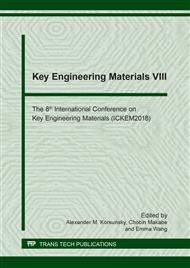[1]
C.C. Ihueze, C.E. Okafor, C.I. Okoye, Natural fiber composite design and characterization for limit stress prediction in multiaxial stress state, J. of King Saud Uni. – Eng. Sci. (2015) 193-206.
DOI: 10.1016/j.jksues.2013.08.002
Google Scholar
[2]
G. Dorez, L. Ferry, R. Sonnier, A. Taguet, J.-M. Lopez-Cuesta, Effect of cellulose, hemicellulose, and lignin contents on pyrolysis and combustion of natural fibers, J. of Analyt. and Appl. Pyro. 107 (2014) 323-331.
DOI: 10.1016/j.jaap.2014.03.017
Google Scholar
[3]
X. Li, C. Sun, B. Zhou, Y. He, Determination of hemicellulose, cellulose and lignin in Moso bamboo by near infrared spectroscopy, Sci. Rep. 5 (2015) 1-11.
DOI: 10.1038/srep17210
Google Scholar
[4]
A.O. Ayeni, O.A. Adeeyo, O.M. Oresegun, T.E. Oladimeji, Compositional analysis of lignocellulosic materials: Evaluation of an economically viable method suitable for woody and non-woody biomass. American J. of Eng. Res. 4 (2015) 14-19.
Google Scholar
[5]
S.R. Djafari Petroudy, Physical and mechanical properties of natural fibers, in: M. Fan, F. Fu (Eds.), Advanced High Strength Natural Fibre Composites in Construction, Woodhead Publishing, Cambridge, 2017, pp.59-83.
DOI: 10.1016/b978-0-08-100411-1.00003-0
Google Scholar
[6]
L. Sisti, G. Totaro, M. Vannini, P. Fabbri, S. Kalia, A. Zatta, A. Celli, Evaluation of the retting process as a pre-treatment of vegetable fibers for the preparation of high-performance polymer biocomposites, Ind. Crops and Prod. 81 (2016) 55-65.
DOI: 10.1016/j.indcrop.2015.11.045
Google Scholar
[7]
M. Liu, D.A.S. Silva, D. Fernando, A.S. Meyer, B. Madsen, G. Daniel, A. Thygesen, Controlled retting of hemp fibres: Effect of hydrothermal pre-treatment and enzymatic retting on the mechanical properties of unidirectional hemp/epoxy composites, Compos. Part A: Appl. Sci. and Manufac. 88 (2016).
DOI: 10.1016/j.compositesa.2016.06.003
Google Scholar
[8]
L.Y. Mwaikambo, M.P. Ansell, The effect of chemical treatment on the properties of hemp, sisal, jute and kapok for composite reinforcement, Macromol. Mater. and Eng. 272 (1999) 108-116.
DOI: 10.1002/(sici)1522-9505(19991201)272:1<108::aid-apmc108>3.0.co;2-9
Google Scholar
[9]
B. Budiansky, Micromechanics, Comput. and Struc. 16 (1983) 3-12.
Google Scholar
[10]
Y.L. Xu, K.L. Reifsnider, Micromechanical modeling of composite compressive strength, 27 (1993) 572-588.
DOI: 10.1177/002199839302700602
Google Scholar
[11]
N.K. Naik, R.S. Kumar, Compressive strength of unidirectional composites: evaluation and comparison of prediction models, 46 (1999) 299-308.
DOI: 10.1016/s0263-8223(99)00098-7
Google Scholar
[12]
T. Matsuo, K. Kageyama, Compressive failure mechanism and strength of unidirectional thermoplastic composites based on modified kink band model, 93 (2017) 117-125.
DOI: 10.1016/j.compositesa.2016.11.018
Google Scholar
[13]
B. Budiansky, N.A. Fleck, Compressive failure of fibre composites, J. of the Mechanics and Physics of Solids, 41 (1993) 183-211.
DOI: 10.1016/0022-5096(93)90068-q
Google Scholar
[14]
C.A. De Carvalho Mendes, F.A. De Oliveira Adnet, M.C.A.M., Leite, C.R. Guimaraes Furtado, A.M.F. De Sousa, Chemical, physical, mechanical, thermal and morphological characterizations of corn husk residue, Cellu. Chem. and Technol. 49 (2015).
Google Scholar
[15]
ASTM D4703-16, Standard practice for compression molding thermoplastic materials into test specimens, plaques, or sheets, ASTM International, West Conshohocken, PA, (2016).
DOI: 10.1520/d4703-00
Google Scholar
[16]
ASTM E41-92, Terminology Relating to Conditioning, ASTM International, West Conshohocken, PA, (2010).
Google Scholar
[17]
ASTM D695-15, Standard test method for compressive properties of rigid plastics, ASTM International, West Conshohocken, PA, (2015).
Google Scholar
[18]
E.S. Rodriguez, A. Vazquez, Alkali treatment of jute fabrics: influence on the processing conditions and the mechanical properties of their composites, in: The 8th Int. Conf. on Flow Proc. in Compos. Mater. (FPCM8), (2006) 105-112.
Google Scholar


